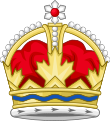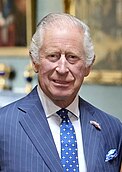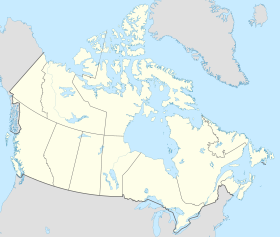|
Politics of Canada
The politics of Canada functions within a framework of parliamentary democracy and a federal system of parliamentary government with strong democratic traditions.[1] Canada is a constitutional monarchy where the monarch is the ceremonial head of state. In practice, executive authority is entrusted to the Cabinet, a committee of ministers of the Crown chaired by the prime minister of Canada that act as the executive committee of the King's Privy Council for Canada and are responsible to the democratically elected House of Commons.[2] Canada is described as a "full democracy",[3] with a tradition of secular liberalism,[4] and an egalitarian,[5] moderate political ideology.[6][7][8] Extremism has never been prominent in Canadian politics.[9][10][11][12][13] The traditional "brokerage" model of Canadian politics leaves little room for ideology.[a][14] Peace, order, and good government, alongside an Implied Bill of Rights, are founding principles of the Canadian government.[15][16] An emphasis on multiculturalism and social justice has been a distinguishing element of Canada's political culture.[17][18][19] Canada has placed emphasis on diversity, equity and inclusion for all its people.[20][21] The country has a multi-party system in which many of its legislative practices derive from the unwritten conventions of and precedents set by the Westminster parliament of the United Kingdom. The two dominant political parties in Canada have historically been the Liberal Party of Canada and the current Conservative Party of Canada (as well as its numerous predecessors).[22] Parties like the New Democratic Party, the Quebec nationalist Bloc Québécois and the Green Party of Canada have grown in prominence, exerting their own influence to the political process.[22] Canada has evolved variations: party discipline in Canada is stronger than in the United States and United Kingdom, and more parliamentary votes are considered motions of confidence, which tends to diminish the role of non-Cabinet members of parliament (MPs). Such members, in the government caucus, and junior or lower-profile members of opposition caucuses, are known as backbenchers. Backbenchers can, however, exert their influence by sitting in parliamentary committees, like the Public Accounts Committee or the National Defence Committee. ContextCanada's governmental structure was originally established by the British Parliament through the British North America Act, 1867 (now the Constitution Act, 1867),[23] but the federal model and division of powers were devised by Canadian politicians. Particularly after World War I, citizens of the self-governing Dominions, such as Canada, began to develop a strong sense of identity, and, in the Balfour Declaration of 1926, the British government and the governments of the six Dominions jointly agreed that the Dominions had full autonomy within the British Commonwealth. In 1931, after further consultations and agreements between the British government and the governments of the Dominions, the British Parliament passed the Statute of Westminster, giving legal recognition to the autonomy of Canada and other Dominions. However, Canadian politicians were unable to obtain consensus on a process for amending the constitution, which was therefore not affected by the Statute of Westminster, meaning amendments to Canada's constitution continued to require the approval of the British parliament until that date. Similarly, the Judicial Committee of the Privy Council in Britain continued to make the final decision on criminal appeals until 1933 and on civil appeals until 1949.[24] It was not until 1982, with the Patriation of the Constitution, that the role of the British Parliament was ended. Political cultureCanada's egalitarian approach to governance has emphasized social welfare, economic freedom, and multiculturalism, which is based on selective economic migrants, social integration, and suppression of far-right politics, that has wide public and political support.[25][26] Its broad range of constituent nationalities and policies that promote a "just society" are constitutionally protected.[27][28] Individual rights, equality and inclusiveness (social equality) have risen to the forefront of political and legal importance for most Canadians, as demonstrated through support for the Charter of Rights and Freedoms, a relatively free economy, and social liberal attitudes toward women's rights (like pregnancy termination), divorce, homosexuality, same-sex marriage, birth control, euthanasia or cannabis use.[29][27][28][20][30] There is also a sense of collective responsibility in Canadian political culture, as is demonstrated in general support for universal health care, multiculturalism, evolution, gun control, foreign aid, and other social programs.[31][32][33][34]
At the federal level, Canada has been dominated by two relatively centrist parties practising "brokerage politics",[a][37][38][39] the centre-left leaning Liberal Party of Canada and the centre-right leaning Conservative Party of Canada (or its predecessors).[40] "The traditional brokerage model of Canadian politics leaves little room for ideology"[41] as the Canadian catch-all party system requires support from a broad spectrum of voters.[35][38][39][37] The historically predominant Liberals position themselves at the centre of the political scale,[42][43][44] with the Conservatives sitting on the right and the New Democratic Party occupying the left.[45][46][47] Five parties had representatives elected to the federal parliament in the 2021 election: the Liberal Party who currently form the government, the Conservative Party who are the Official Opposition, the New Democratic Party, the Bloc Québécois, and the Green Party of Canada.[48] Polls have suggested that Canadians generally do not have a solid understanding of civics.[49] This has been theorized to be a result of less attention being given to the subject in provincial education curricula, beginning in the 1960s.[50] By 2008, a poll showed only 24 per cent of respondents could name the monarch as head of state.[51] Likewise, Senator Lowell Murray wrote five years earlier that "the Crown has become irrelevant to most Canadians' understanding of our system of Government."[52] As John Robson of the National Post opined in 2015: "Intellectually, voters and commentators succumb to the mistaken notion that we elect 'governments' of prime ministers and cabinets with untrammelled authority, that indeed ideal 'democracy' consists precisely in this kind of plebiscitary autocracy."[53] Governmental organization
Monarchy
Charles III, King of Canada, the country's head of state Mary Simon, Governor General of Canada, the monarch's representative
Elizabeth II, Queen of Canada, Quebec City, 1964
Canada is a constitutional monarchy, wherein the role of the reigning sovereign is both legal and practical, but not political.[55] The monarch is vested with all powers of state[56] and sits at the centre of a construct in which the power of the whole is shared by multiple institutions of government acting under the sovereign's authority.[57][58][59][60] The executive is thus formally referred to as the King-in-Council, the legislature as the King-in-Parliament, and the courts as the King-on-the-Bench.[61] Though the person who is monarch of Canada (currently Charles III) is also the monarch of 14 other countries in the Commonwealth of Nations, he nevertheless reigns separately as King of Canada, an office that is "truly Canadian" and "totally independent from that of the monarch of the United Kingdom or the other Commonwealth realms."[62][63] On the advice of the Canadian prime minister, the sovereign appoints a federal viceregal representative—the governor general(currently Mary Simon)—who, since 1947, is permitted to exercise almost all of the monarch's royal prerogative; though, there are some duties which must be specifically performed by the monarch themselves (such as assent of certain bills). In case of the governor general's absence or incapacitation, the administrator of Canada performs the Crown's most basic functions. Royal assent is required to enact laws. As part of the royal prerogative, the royal sign-manual gives authority to letters patent and orders-in-Council. Much of the royal prerogative is only exercised in-council, on the advice of the Cabinet;[64][65] within the conventional stipulations of a constitutional monarchy, the sovereign's direct participation in any of these areas of governance is limited.[66][67] The royal prerogative also includes summoning, proroguing, and dissolving Parliament in order to call an election and extends to foreign affairs, which include the negotiation and ratification of treaties, alliances, international agreements, and declarations of war;[68] the accreditation of Canadian diplomats and receipt of foreign diplomats; and the issuance of passports.[69] Executive power
Legislative powerThe bicameral Parliament of Canada consists of three parts: the monarch, the Senate, and the House of Commons. Currently, the Senate, which is frequently described as providing regional representation, has 105 members appointed by the Governor-General on the advice of the Prime Minister to serve until age 75. It was created with equal representation from the three regions of Ontario, Quebec, and the Maritimes (originally New Brunswick and Nova Scotia, expanded in 1873 to include Prince Edward Island). In 1915, a new Western division was created, with six senators from each of the four western provinces, so that each of the four regions had 24 seats in the Senate. When Newfoundland and Labrador joined Confederation in 1949, it was not included in an existing region and was assigned six seats. Each of the three territories has one seat. It is not based on representation-by-population. The normal number of senators can be exceeded by the monarch on the advice of the Prime Minister, as long as the additional senators are distributed equally with regard to region (up to a total of eight additional Senators). This power of additional appointment has only been used once, when Prime Minister Brian Mulroney petitioned Queen Elizabeth II to add eight seats to the Senate so as to ensure the passage of the Goods and Services Tax legislation.  The House of Commons currently has 338 members elected in single-member districts in a plurality voting system (first past the post), meaning that members must attain only a plurality (the most votes of any candidate) rather than a majority. The electoral districts are also known as ridings. Mandates cannot exceed five years; an election must occur by the end of this time. This fixed mandate has been exceeded only once, when Prime Minister Robert Borden perceived the need to do so during World War I. A constitutional amendment was passed, extending the life of the Parliament by one year, by the unanimous consent of the House of Commons. The size of the House and apportionment of seats to each province is revised after every census, conducted every five years, and is based on population changes and approximately on representation-by-population. Elections and government formation
Canadians vote for the election of their local member of parliament (MP) only. A vote is cast directly for a candidate. The candidate in each riding who receives a plurality of votes (first-past-the-post system) is elected.[70] An MP need not be a member of any political party: such MPs are known as independents. When a number of MPs share political opinions they may form a body known as a political party. The Canada Elections Act defines a political party as "an organization one of whose fundamental purposes is to participate in public affairs by endorsing one or more of its members as candidates and supporting their election." Forming and registering a federal political party are two different things. There is no legislation regulating the formation of federal political parties. Elections Canada cannot dictate how a federal political party should be formed or how its legal, internal and financial structures should be established.[71] Most parties elect their leaders in instant-runoff elections to ensure that the winner receives more than 50% of the votes. Normally the party leader stands as a candidate to be an MP during an election. This happens at leadership conventions. Canada's parliamentary system empowers political parties and their party leaders. Where one party gets a majority of the seats in the House of Commons, that party is said to have a "majority government." Through party discipline, the party leader, who is elected in only one riding, exercises a great deal of control over the cabinet and the parliament.[72] Historically, the prime minister and senators are selected by the Governor General as a representative of the King, though in modern practice the monarch's duties are ceremonial. Consequently, the prime minister, while technically selected by the Governor General, is for all practical purposes selected by the party with the majority of seats. That is, the party that gets the most seats normally forms the government, with that party's leader becoming prime minister. The prime minister is not directly elected by the general population, although the prime minister is almost always directly elected as an MP within his or her constituency. Often the most popular party in an election takes a majority of the seats, even if it did not receive a majority of the vote. However, as there are usually three or more political parties represented in parliament, often no party takes a majority of the seats. A minority government occurs when the party that holds the most seats in the House of Commons holds fewer seats than the opposition parties combined. Where no party is given a majority, the defeated Ministry may choose to stay in office until defeated on a vote of confidence in the House, or it may resign. If it resigns, the Governor General will ask the leader of the opposition party most likely to enjoy the confidence of the House to form a government;[73] however, for the government to survive and to pass laws, the leader chosen must have the support of the majority of the House, meaning they need the support of the elected members of at least one other party. This can be done on a case-by-case basis, through a coalition government (which has only occurred once at the federal level, the Unionist government formed during World War I) or through a confidence-and-supply agreement (such as the one the Liberals and the NDP signed in 2022). Federal-provincial relations
 As a federation, the existence and powers of the federal government and the ten provinces are guaranteed by the Constitution. The Constitution Act, 1867 sets out the basic constitutional structure of the federal government and the provinces.[23] The powers of the federal Parliament and the provinces can only be changed by constitutional amendments passed by the federal and provincial governments.[74] The Crown is the formal head of state of the federal government and each of the ten provinces, but rarely has any political role. The governments are led by the representatives of the people: elected by all Canadians, at the federal level, and by the Canadian citizens of each provinces, at the provincial level. Federal-provincial (or intergovernmental, formerly Dominion-provincial) relations is a regular issue in Canadian politics: Quebec wishes to preserve and strengthen its distinctive nature, western provinces desire more control over their abundant natural resources, especially energy reserves; industrialized Central Canada is concerned with its manufacturing base, and the Atlantic provinces strive to escape from being less affluent than the rest of the country.[75] In order to ensure that social programs such as health care and education are funded consistently throughout Canada, the "have-not" (poorer) provinces receive a proportionately greater share of federal "transfer (equalization) payments" than the richer, or "have", provinces do; this has been somewhat controversial. The richer provinces often favour freezing transfer payments, or rebalancing the system in their favour, based on the claim that they already pay more in taxes than they receive in federal government services, and the poorer provinces often favour an increase on the basis that the amount of money they receive is not sufficient for their existing needs.[75] Particularly in the past decade, critics have argued that the federal government's exercise of its unlimited constitutional spending power has contributed to strained federal-provincial relations.[76][77][78][79] This power allows the federal government to influence provincial policies, by offering funding in areas that the federal government cannot itself regulate. The federal spending power is not expressly set out in the Constitution Act, 1867; however, in the words of the Court of Appeal for Ontario the power "can be inferred" from s. 91(1A), "the public debt and property".[80] A prime example of an exercise of the spending power is the Canada Health Act, which is a conditional grant of money to the provinces. Regulation of health services is, under the Constitution, a provincial responsibility. However, by making the funding available to the provinces under the Canada Health Act contingent upon delivery of services according to federal standards, the federal government has the ability to influence health care delivery. Quebec and Canadian politicsExcept for three short-lived transitional or minority governments, prime ministers from Quebec led Canada continuously from 1968 to early 2006. People from Quebec led both Liberal and Progressive Conservative governments in this period. Monarchs, governors general, and prime ministers are now expected to be at least functional, if not fluent, in both English and French. In selecting leaders, political parties give preference to candidates who are fluently bilingual. By law, three of the nine positions on the Supreme Court of Canada must be held by judges from Quebec. This representation makes sure that at least three judges have sufficient experience with the civil law system to treat cases involving Quebec laws.[81] National unity
Canada has a long and storied history of secessionist movements (see Secessionist movements of Canada). National unity has been a major issue in Canada since the forced union of Upper and Lower Canada in 1840. The predominant and lingering issue concerning Canadian national unity has been the ongoing conflict between the French-speaking majority in Quebec and the English-speaking majority in the rest of Canada. Quebec's continued demands for recognition of its "distinct society" through special political status has led to attempts for constitutional reform, most notably with the failed attempts to amend the constitution through the Meech Lake Accord and the Charlottetown Accord (the latter of which was rejected through a national referendum). Since the Quiet Revolution, sovereigntist sentiments in Quebec have been variably stoked by the patriation of the Canadian constitution in 1982 (without Quebec's consent) and by the failed attempts at constitutional reform. Two provincial referendums, in 1980 and 1995, rejected proposals for sovereignty with majorities of 60% and 50.6% respectively. Given the narrow federalist victory in 1995, a reference was made by the Chrétien government to the Supreme Court of Canada in 1998 regarding the legality of unilateral provincial secession. The court decided that a unilateral declaration of secession would be unconstitutional. This resulted in the passage of the Clarity Act in 2000. The Bloc Québécois, a sovereigntist party which runs candidates exclusively in Quebec, was started by a group of MPs who left the Progressive Conservative (PC) party (along with several disaffected Liberal MPs), and first put forward candidates in the 1993 federal election. With the collapse of the PCs in that election, the Bloc and Liberals were seen as the only two viable parties in Quebec. Thus, prior to the 2006 election, any gain by one party came at the expense of the other, regardless of whether national unity was really at issue. The Bloc, then, benefited (with a significant increase in seat total) from the impressions of corruption that surrounded the Liberal Party in the lead-up to the 2004 election. However, the newly unified Conservative party re-emerged as a viable party in Quebec by winning 10 seats in the 2006 election. In the 2011 election, the New Democratic Party succeeded in winning 59 of Quebec's 75 seats, successfully reducing the number of seats of every other party substantially. The NDP surge nearly destroyed the Bloc, reducing them to 4 seats, far below the minimum requirement of 12 seats for Official party status. Newfoundland and Labrador is also a problem regarding national unity. As the Dominion of Newfoundland was a self-governing country equal to Canada until 1949, there are large, though unco-ordinated, feelings of Newfoundland nationalism and anti-Canadian sentiment among much of the population. This is due in part to the perception of chronic federal mismanagement of the fisheries, forced resettlement away from isolated settlements in the 1960s, the government of Quebec still drawing inaccurate political maps whereby they take parts of Labrador, and to the perception that mainland Canadians look down upon Newfoundlanders. In 2004, the Newfoundland and Labrador First Party contested provincial elections and in 2008 in federal ridings within the province. In 2004, then-premier Danny Williams ordered all federal flags removed from government buildings as a result of lost offshore revenues to equalization clawbacks.[82] On December 23, 2004, premier Williams made this statement to reporters in St. John's,
Western alienation is another national-unity-related concept that enters into Canadian politics. Residents of the four western provinces, particularly Alberta, have often been unhappy with a lack of influence and a perceived lack of understanding when residents of Central Canada consider "national" issues. While this is seen to play itself out through many avenues (media, commerce, and so on.), in politics, it has given rise to a number of political parties whose base constituency is in western Canada. These include the United Farmers of Alberta, who first won federal seats in 1917, the Progressives (1921), the Social Credit Party (1935), the Co-operative Commonwealth Federation (1935), the Reconstruction Party (1935), New Democracy (1940) and most recently the Reform Party (1989). The Reform Party's slogan "The West Wants In" was echoed by commentators when, after a successful merger with the PCs, the successor party to both parties, the Conservative Party won the 2006 election. Led by Stephen Harper, who is an MP from Alberta, the electoral victory was said to have made "The West IS In" a reality. However, regardless of specific electoral successes or failures, the concept of western alienation continues to be important in Canadian politics, particularly on a provincial level, where opposing the federal government is a common tactic for provincial politicians. For example, in 2001, a group of prominent Albertans produced the Alberta Agenda, urging Alberta to take steps to make full use of its constitutional powers, much as Quebec has done. Political conditions
Canada is considered by most sources to be a very stable democracy. In 2006, The Economist ranked Canada the third-most democratic nation in its Democracy Index, ahead of all other nations in the Americas and ahead of every nation more populous than itself. According to the V-Dem Democracy indices, in 2023 Canada was the 19th most electoral democratic country in the world.[83][84] More recently, with the existence of strong third parties and first-past-the-post elections amongst other factors, Canada on a federal and provincial level has experienced huge swings in seat shares, where third parties (e.g. NDP, Reform) end up (usually briefly) replacing the Liberals, the Progressive Conservatives or the Conservatives as the main opposition or even the government and leaving them as a rump. Such examples federally include the 1993 federal election with the collapse of the Progressive Conservatives, and the 2011 election leaving the Liberal Party a (temporary) rump along with Bloc Québécois. Other examples include the changes of fortune for the Alberta NDP during the province's 2015 and 2019 elections, and possibly the 2018 Quebec elections with the rise of Coalition Avenir Québec taking government from the Liberals and Parti Québécois. 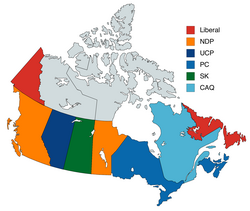 On a provincial level, in the legislatures of western provinces the NDP often is the left-leaning main party instead of that province's Liberal Party branch, the latter generally being a rump or smaller than the NDP. The other main party (right of the NDP) is either the Progressive Conservatives or their successor, or the Saskatchewan Party in Saskatchewan.[85] Party systemsAccording to recent scholars, there have been four party systems in [Canada] at the federal level since Confederation, each with its own distinctive pattern of social support, patronage relationships, leadership styles, and electoral strategies.[86] Political scientists disagree on the names and precise boundaries of the eras, however. Steve Patten identifies four party systems in Canada's political history[87] Clarkson (2005) shows how the Liberal Party has dominated all the party systems, using different approaches. It began with a "clientelistic approach" under Laurier, which evolved into a "brokerage" system of the 1920s, 1930s and 1940s under Mackenzie King. The 1950s saw the emergence of a "pan-Canadian system", which lasted until the 1990s. The 1993 election — categorized by Clarkson as an electoral "earthquake" which "fragmented" the party system, saw the emergence of regional politics within a four party-system, whereby various groups championed regional issues and concerns. Clarkson concludes that the inherent bias built into the first-past-the-post system, has chiefly benefited the Liberals.[88] Party fundingThe rules governing the funding of parties are designed to ensure reliance on personal contributions. Personal donations to federal parties and campaigns benefit from tax credits, although the amount of tax relief depends on the amount given. Also only people paying income taxes receive any benefit from this. The rules are based on the belief that union or business funding should not be allowed to have as much impact on federal election funding as these are not contributions from citizens and are not evenly spread out between parties. The new rules stated that a party had to receive 2% of the vote nationwide in order to receive the general federal funding for parties. Each vote garnered a certain dollar amount for a party (approximately $1.75) in future funding. For the initial disbursement, approximations were made based on previous elections. The NDP received more votes than expected (its national share of the vote went up) while the new Conservative Party of Canada received fewer votes than had been estimated and was asked to refund the difference. Quebec was the first province to implement a similar system of funding many years before the changes to funding of federal parties.[89] Federal funds are disbursed quarterly to parties, beginning at the start of 2005. For the moment, this disbursement delay leaves the NDP and the Green Party in a better position to fight an election, since they rely more on individual contributors than federal funds. The Green Party now receives federal funds, since it for the first time received a sufficient share of the vote in the 2004 election.[90] In 2007, news emerged of a funding loophole that "could cumulatively exceed the legal limit by more than $60,000", through anonymous recurrent donations of $200 to every riding of a party from corporations or unions. At the time, for each individual, the legal annual donation limit was $1,100 for each party, $1,100 combined total for each party's associations, and in an election year, an additional $1,100 combined total for each party's candidates. All three limits increase on 1 April every year based on the inflation rate.[91][92][93] Two of the biggest federal political parties in Canada experienced a drop in donations in 2020, in light of the COVID-19 pandemic impact on the global economy.[94] Political parties, leaders and statusOrdered by number of elected representatives in the House of Commons
Leaders' debatesLeaders' debates in Canada consist of two debates, one English and one French,[95] both produced by a consortium of Canada's five major television broadcasters (CBC/SRC, CTV, Global and TVA) and usually consist of the leaders of all parties with representation in the House of Commons. These debates air on the networks of the producing consortium as well as the public affairs and parliamentary channel CPAC and the American public affairs network C-SPAN. Judiciary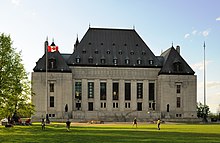 The court system of Canada is made up of many courts differing in levels of legal superiority and separated by jurisdiction. In the courts, the judiciary interpret and apply the law of Canada. Some of the courts are federal in nature, while others are provincial or territorial. The Constitution of Canada gives the federal Parliament of Canada exclusive jurisdiction in criminal law, while the provinces have exclusive control over much of civil law.[96] Each province has authority over the administration of justice within that province.[97]Government departments and structureThe Canadian government operates the public service using departments, smaller agencies (for example, commissions, tribunals, and boards), and crown corporations. There are two types of departments: central agencies such as Finance, Privy Council Office, and Treasury Board Secretariat have an organizing and oversight role for the entire public service; line departments are departments that perform tasks in a specific area or field, such as the departments of Agriculture, Environment, or Defence.
Scholar Peter Aucoin, writing about the Canadian Westminster system, raised concerns in the early 2000s about the centralization of power; an increased number, role and influence of partisan-political staff; personal-politicization of appointments to the senior public service; and the assumption that the public service is promiscuously partisan for the government of the day.[98] Elections
See also
Notes
References
Further reading
External linksWikimedia Commons has media related to Politics of Canada.
|
|||||||||||||||||||||||||||||||||||||||||||||||||||||||||||||||||||||||||||||||||||||||||
